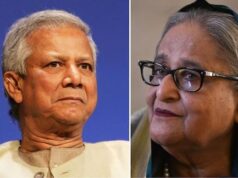There Is No Comparison Between India And Pakistan Any More

By
Colonel Awadhesh Kumar, Special Forces
Recently one Kyle Mizokami again went in a round about way to state that India must give up its nuclear weapons. He seems to be really afraid and concerned about India getting involved in a nuclear war where millions of Indians will be getting killed. He is afraid that there will be a huge economic set back for India. So he wants that India should sit with Pakistan and both sides must sign an agreement to limit the numbers of their nuclear weapons.
His idea is very impressive and profound. He needs to suggest the same to both North Korea and United States of America. Once both of them sign an agreement to limit their nuclear weapons then India too will sit with China- Pakistan combined and sign an agreement on limiting the nuclear weapons.
Meanwhile Mizokami must tell Pakistan that in case the Line of Control incidents goes out of hand then Pakistan may get slammed so hard that may have to recount their Protons and Neutrons inside the molecules left of Pakistan. India is not eager to wage a War but now it will not tolerate terrorism any more instead will make the prepators and supporters of terrorism, pay very heavily. So the onus of the many border incidents between the two countries spiraling out of control into a conventional war will rest solely on Pakistan. In case Pakistan brings up the threat of a nuclear war then it will simply cease to exist. While in wars past Pakistan only lost a part of its country, a nuclear war would ensure that it gets eradicated.
Pakistan has been waging war with India since 1947. When the the British finally realized that now there was no way to continue their loot of India and therefore they must quit when the going was still good. However before quitting they played a last over of their GREAT GAME and ensured creation of Pakistan.The Pakistanis have gone to war four times since then, in 1947, 1965, 1971 and 1999, and been on the brink of war as recently as 2008. The last war, the 1999 Kargil War, was particularly dangerous as India just stopped short of taking the war into Pakistan.
India could have tested its first nuclear device as early as 1964, right after the Chinese nuclear test. However it did so only in 1974 under code name “Smiling Buddha,”,when it saw that China was making rapid advances in the field.India has been prompted to build nuclear weapons not only by China but the discriminatory behaviour of other nuclear powers too. Though India maintained a moratorium on further tests until May 1998, when it conducted five tests in rapid order, including four fission and one fusion bomb, all were highly successful. The success of the thermo nuclear device took the Western World by total surprise.
Today the country has enough nuclear warheads divided among India’s nuclear triad comprising nuclear-capable strike aircraft, land-based missiles and the SSBN submarines. This has enabled India flexible nuclear options capable of surviving a first strike by another nuclear state of any variety. India till now has a No First Use policy, vowing not to use nuclear weapons first in a conflict. Though this needs to change with respect to Pakistan.
India is also constructing a fleet of ballistic-missile submarines of which INS ARIHANT and ARIGHAT are already deployed, equipped with both short- and medium-range ballistic missiles, Arihant can carry twelve K-15 Sagarika short-range ballistic missiles with maximum range of 700km, or alternately, four K-4 medium-range ballistic missiles with a 3500km range. These submarines provide a crucial second-strike capability capable of launching a devastating retaliatory barrage along with rail/ road/ silo based missiles of 8000km range.
Pakistan is estimated to have an arsenal of 110 to 130 nuclear weapons, to be steadily growing. Unlike India, Pakistan does not appear to have vastly more powerful thermonuclear weapons. Dangerously for the very existence of Pakistan, it does not have a No First Use policy. Since the Carnegie Endowment for International Peace and the Stimson Centre has estimated Pakistan’s bomb-making capability at twenty devices annually since 2015. At such a rate Pakistan could easily become the fourth- or even third-largest nuclear power in the world. This can be used as an excuse by India to eliminate such venomous threat by saying a GOOD BYE to its NO FIRST USE POLICY.
Pakistan they say is also developing a “triad” of land-, air- and sea-based nuclear delivery systems. Islamabad is believed to have modified American-built F-16A fighters and possibly French-made Mirage fighters to deliver nuclear bombs. Land-based missile systems are Hatf series of mobile missiles includes the solid fuelled Hatf-III 280 km, solid fuelled Hatf-IV 750 km and liquid fuelled Hatf V 1100km. An even longer-range missile, Hatf VI 2000km, is probably now entering service. In order to counter threats stationed on the Nicobar and Andaman Islands, Pakistan is also developing the Shaheen III intermediate-range missile, capable of striking targets out to 3000km.
What would a nuclear war be like? A nuclear war in South Asia would start out as a conventional war, which might very well be sparked by a cross-border incident. Uncontrolled escalation could lead to conflict between land, sea and air forces on both sides. The inclination would be for Pakistan, especially when seeing tank spearheads barreling down on its major cities, to deploy tactical nuclear weapons.
Tactical nuclear weapons, used inside Pakistan although might halt the Indian offensive momentarily, would bring the risk of all-out nuclear strike by India, as loss of its Armoured Brigades cannot be left unpunished. Then India will have no choice but unleash an all-out nuclear attack to not only destroy the Paki nukes but decapitate the government to prevent further launches.
Targets would include nuclear research centres, known nuclear weapons facilities, air bases where nuclear-armed aircraft are based, military ports and military headquarters. Many of these would be in and around major metropolitan areas, thus causing severe civilian casualties in Pakistan.
A two-hundred-kiloton thermonuclear device dropped on Islamabad, the kind which India had tested in 1998, would kill nearly 225,000 and injure 442,000 more. A fifty-kiloton strike on Karachi would kill eight hundred thousand and injure 1.8 million more. The latest thermonuclear device will be more lethal.
The only way out for Pakistan is to declare a No First Use Policy, just like India and China and thus take an insurance policy against an Indian Preemptive Nuclear Strike.




